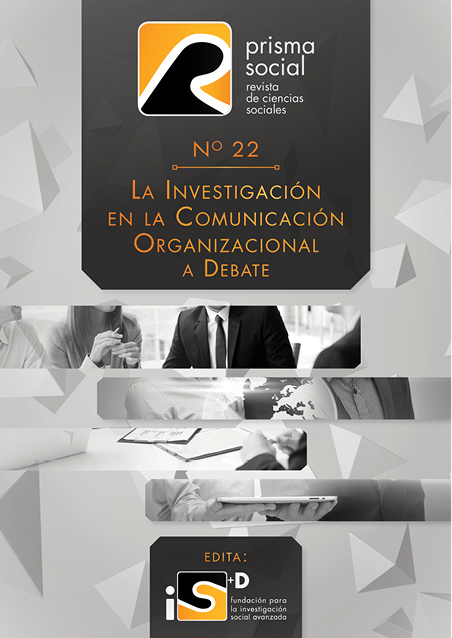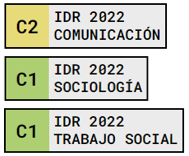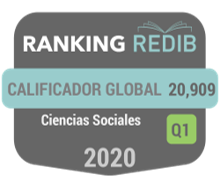Universidad y medios sociales. Gestión de la comunicación en la universidad española
Palabras clave:
universidad, branding, social mediaResumen
La implantación y crecimiento de los medios sociales en la sociedad deja poco margen de elección a las universidades. Teniendo en cuenta el número de usuarios/as de estos medios, parecen ser una herramienta fundamental para fortalecer las relaciones de las universidades con sus públicos (Cancelo-Sanmartin & Almansa-Martinez, 2013). Quizás por esto las redes sociales están siendo un creciente objeto de estudio en el contexto de la investigación universitaria (Clark, Fine, & Scheuer, 2017).
La presencia corporativa de las universidades españolas en los medios sociales es una realidad pero, no es suficiente con crear un perfil corporativo en las redes más populares sino que dicha presencia debe responder a objetivos estratégicos.
En el presente estudio se ha realizado una encuesta a los/as responsables de la comunicación digital de 17 universidades españolas a los que se preguntó por la estrategia de comunicación, los públicos y los contenidos de las comunicaciones en los medios sociales. Los resultados indican una importancia creciente de estos medios en los planes de comunicación y confirman que las universidades buscan comunicarse, principalmente, con los/as estudiantes.
Descargas
Citas
Arquero, J.L & Romero-Frías, E. (2013). Using social network sites in Higher Education: an experience in business studies, Innovations in Education and Teaching International, 50 (3)3, 238-249, DOI: 10.1080/14703297.2012.760772
Benson, V, Saridakis, G. & Tennakoon, H. (2015). Purpose of social networking use and victimisation: Are there any differences between university students and those not in HE? Computers in Human Behavior, 51, 867–872.
Cancelo-Sanmartin, M.; Almansa-Martinez, A. (2013). Communication strategies in social networks. Comparative Study between Spain and Mexico universities. Historia y Comunicación Social, 18 (esp), 423-435.
Chapleo, C.; Carrillo Durán, MV. & Castillo Díaz, A. (2011). Do UK universities communicate their brands effectively through their websites?, Journal of Marketing for Higher Education, 21(1), 25-46, DOI: 10.1080/08841241.2011.569589
Clark, M., M.B. Fine, y C.L. Scheuer (2017). Relationship quality in higher education marketing: the role of social media engagement. Journal of Marketing for Higher Education, 27 (1), 40-58.
European Commission (2008). Higher Education Governance in Europe. Policies, structures, funding and academic staff. Bruselas: Eurydice.
Fournier, S. and Avery, J. (2011). The uninvited brand. Business Horizons, 54 (3), 193-207.
García-Galera, M., & Fernández-Muñoz, C. (2016). Si lo vives, lo compartes. Cómo se comunican los jóvenes en el mundo digital. Barcelona: Fundación Telefónica.
Gómez, M.; Roses, S. & Farias, P. (2012). The Academic Use of Social Networks among University Students. Comunica Journal, 38, 131-138. Disponible en: http://www.revistacomunicar.com/index.php?contenido=detalles&numero=38&articulo=38-2012-16
González-Díaz, C. Iglesias-García, M. & Codina, Ll. (2015). Presencia de las universidades españolas en las redes sociales digitales científicas: caso de los estudios de comunicación. El Profesional de la Información, 24(5), 640-647. doi:10.3145/epi.2015.sep.12
IAB (2016): Estudio anual de redes sociales. Disponible en: http://www.iabspain.net/wp-content/uploads/downloads/2016/04/IAB_EstudioRedesSociales_2016_VCorta.pdf
Kaplan, A. M., & Haenlein, M. (2010). Users of the world, unite! The challenges and opportunities of social media. Business Horizons, 53(1), 59–68.
Karami, S. & Naghibi, H.S. (2014). Social Media Marketing strategies for small to medium enterprises. International Journal of Sales & Marketing Management Research and Development, 4 (4), 11-20.
Karjaluoto, H.; Mustonen, N. & Ulkuniemi, P. (2015). The role of digital channels in industrial marketing communications. Journal of Business & Industrial Marketing, 30 (6), 703-710 http://dx.doi.org/10.1108/JBIM-04-2013-0092
Killian, G. & McManus, K. (2015). A marketing communications approach for the digital era: Managerial guidelines for social media integration. Business Horizons, 58 (5), 539–549
Knight, CG. & Kaye, L.K (2016). ‘To tweet or not to tweet?’ A comparison of academics’ and students’ usage of Twitter in academic contexts, Innovations in Education and Teaching International, 53(2), 145-155, DOI: 10.1080/14703297.2014.928229
Labrecque, L.I (2014). Fostering Consumer–Brand Relationships in Social Media Environments: The Role of Parasocial Interaction. Journal of Interactive Marketing, 28 (2), 134–148. doi:10.1016/j.intmar.2013.12.003
Lacayo-Mendoza, A. & de Pablos-Heredero, C. (2016). Managing relationships and communications in higher education efficiently through digital social networks: The importance of the relational coordination model. DYNA 83 (195), 138-146.DOI: http://dx.doi.org/10.15446/dyna.v83n195.49296
Lafuente-Ruiz-de-Sabando, A., et al. (2018). A review of higher education image and reputation literature: Knowledge gaps and a research agenda. European Research on Management and Business Economics, 24 (1), 8-16 http://dx.doi.org/10.1016/j.iedeen.2017.06.005
Lee, K. (2017). Rethinking the accessibility of online higher education: A historical review. The Internet and Higher Education, 33(1), 15-23. doi: http://dx.doi.org/10.1016/j.iheduc.2017.01.001
Lipiäinen, H.S.M & Karjaluoto, H. (2015). Industrial branding in the digital age, Journal of Business & Industrial Marketing, 30 (6), 733 – 741. http://dx.doi.org/10.1108/JBIM-04-2013-0089
Lopes, P.& Varela, M. (2014). Global university environment – which marketing strategies?, INTED2014 Proceedings, 3086-3094.
Marcelino Mercedes, G. V. (2015). Migración de losjóvenes españoles en redes sociales, de Tuenti a Facebook y de Facebook a Instagram. La segunda migración, Icono 14, 13, 48-72. doi: 10.7195/ri14.v13i2.821
Matsuo, H.; McIntyre, K.;Tomazic, T. & Katz, B. (2004). The Online Survey: Its Contributions and Potential Problems. Proceedings of the Survey Research Methods Section, American Statistical Association. Disponible en: http://www.amstat.org/sections/srms/Proceedings/y2004/files/Jsm2004-000440.pdf
Ministerio de Educación (2017). Sistema Integrado de Información Universitaria . Disponible en: http://www.mecd.gob.es/educacion-mecd/areas-educacion/universidades/estadisticas-informes/siiu.html
Omilion-Hodges, L.M & McClain, K.L. (2016). University use of social media and the crisis lifecycle: Organizational messages, first information responders’ reactions, reframed messages and dissemination patterns. Computers in Human Behavior, 54, 630–638. doi:10.1016/j.chb.2015.06.002
Pergolino, M, Rothman, D., Miller, J. & Miller, J. (2012). The Definitive Guide to Social Marketing. A Marketo Workbook. Disponible en: http://www.slideshare.net/ntdlife/definitive-guidetosocialmarketing-32648238.
Plewa, C.; Ho, J.; Conduit, J. & Karpen, I.O. (2016). Reputation in higher education: A fuzzy set analysis of resource configurations. Journal of Business Research, 69(8):3087-3095. http://dx.doi.org/10.1016/j.jbusres.2016.01.024
Raj, E. D., & Babu, L. D. (2017). An enhanced trust prediction strategy for online social networks using probabilistic reputation features. Neurocomputing, 219, 412-421.
Shields, R. (2016). Following the leader? Network models of “world-class” universities on Twitter. Higher Education, 71 (2), 253-268. DOI 10.1007/s10734-015-9900-z
Snoeijers, EM , Poels, K, C & Nicolay, C. (2014). #universitycrisis: The Impact of Social Media Type, Source, and Information on Student Responses Toward a University Crisis, Social Science Computer Review, 32 (5), 647-661 [doi>10.1177/0894439314525025]
Szwajca, D. (2017). The role of social media in corporate reputation management. The results of the polish enterprises. Foundations of Management, 9, 161-174. DOI: 10.1515/fman-2017-0013
Valerio, G., Herrera-Murillo, D., Villanueva, F., Herrera-Murillo, N. and Rodríguez-Martínez, M. C. (2015). The Relationship between Post Formats and Digital Engagement: A Study of the Facebook Pages of Mexican Universities. RUSC. Universities and Knowledge Society Journal, 12(1), 50-63. doi: http://dx.doi.org/10.7238/rusc.v12i1.1887
Zailskaite-Jakste, L. & Kuvykaite, R. (2012). Implementation of Communication in Social Media by Promoting Studies at Higher Education Institutions. Inzinerine Ekonomika-Engineering Economics, 23(2), 174-188. http://dx.doi.org/10.5755/j01.ee.23.2.1550
Descargas
Publicado
Cómo citar
Número
Sección
Licencia
Los autores/as que publiquen en esta revista aceptan las siguientes condiciones:
- Los autores/as conservan los derechos de autor.
- Los autores/as ceden a la revista el derecho de la primera publicación. La revista también posee los derechos de edición.
- Todos los contenidos publicados se regulan mediante una Licencia Atribución/Reconocimiento-SinDerivados 4.0 Internacional. Acceda a la versión informativa y texto legal de la licencia. En virtud de ello, se permite a terceros utilizar lo publicado siempre que mencionen la autoría del trabajo y a la primera publicación en esta revista. Si transforma el material, no podrá distribuir el trabajo modificado.
- Los autores/as pueden realizar otros acuerdos contractuales independientes y adicionales para la distribución no exclusiva de la versión del artículo publicado en esta revista (p. ej., incluirlo en un repositorio institucional o publicarlo en un libro) siempre que indiquen claramente que el trabajo se publicó por primera vez en esta revista.
- Se permite y recomienda a los autores/as a publicar su trabajo en Internet (por ejemplo en páginas institucionales o personales), una vez publicado en la revista y citando a la misma ya que puede conducir a intercambios productivos y a una mayor y más rápida difusión del trabajo publicado (vea The Effect of Open Access).


















